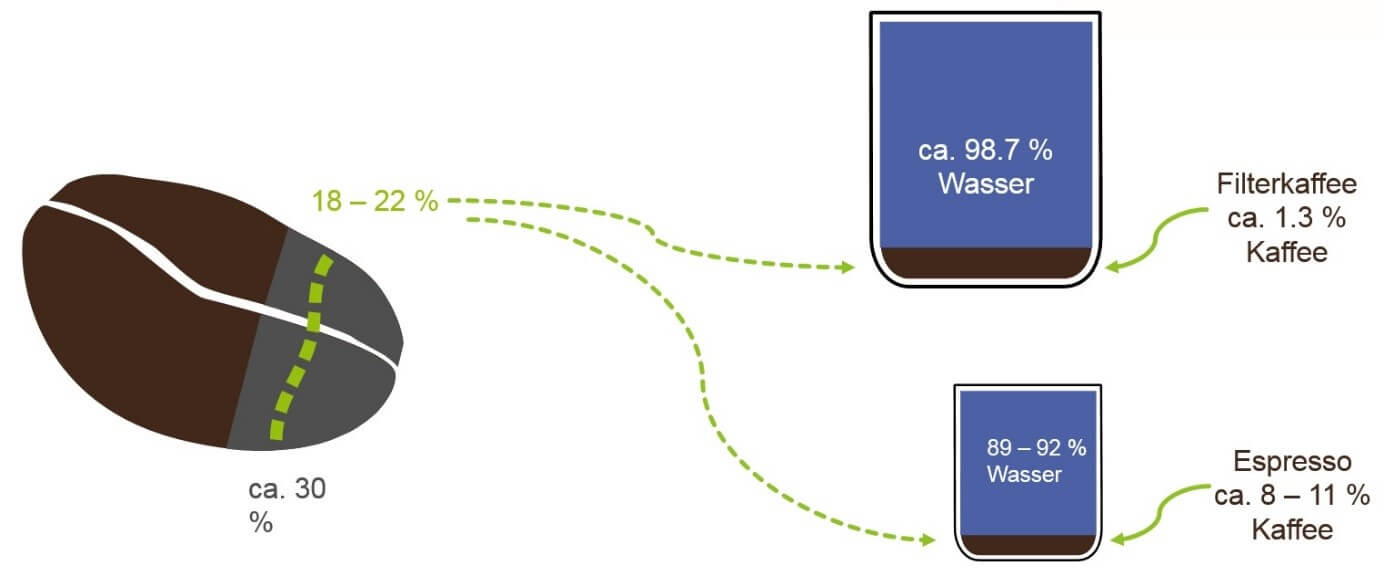What we can extract from coffee, what we should extract, and how this affects the strength of the coffee beverage.
"A bit over-extracted and bitter," the barista whispers, adjusting the espresso grinder. Moments later, and with a few coarser grinds, the coffee brews smoothly and the extraction is just right. The result is a perfect cup that captures the full flavor potential of the coffee bean. A potential that is cultivated by coffee producers in the country of origin and by processing roasters.
Brewing coffee is nothing other than tapping into this potential, or rather, making it soluble. "Making it soluble" is the key word. Grinding breaks down the cell structure of the coffee beans, increasing the surface area of the coffee and thus making it accessible to water. The solids become gaseous and liquid, forming the flavor components that we perceive in the coffee beverage: taste, aroma, body, and brown-red hue. What we taste are chemical compounds whose solubility varies and which, depending on the extraction and intensity, lead to very different results in the cup.
Two perspectives simplify understanding the brewing process. What we extract from the coffee bean is called "extraction." As dissolved particles in the cup, we call this the "strength" of our drink, meaning the concentration of the dissolved coffee.
Strength and concentration of dissolved coffee particles
Every coffee beverage is ultimately a mixture of water and a specific amount of coffee particles, or strength. A filter coffee, for example, consists of approximately 98.5% water and 1.5% dissolved coffee particles. An espresso, which is also perceived as much "stronger" and more intense, consists of approximately 90-92% water and correspondingly 8-10% dissolved coffee particles. When we talk about strength, we are referring to the concentration of coffee in relation to water. The dissolved coffee particles are called Total Dissolved Solids (TDS). The TDS concentration can be measured with a refractometer .
Extraction of coffee – what we take from the bean
About 30% can be extracted from each coffee bean. Everything else is cellular material, oil, and protein, and is insoluble by normal and readily available means. However, not everything we can extract from a coffee bean tastes good. There's a fine line between too much and too little extraction, which we perceive sensorially in every cup of coffee.
Overextraction – too much extracted
If a coffee tastes more bitter than we're used to, we've probably extracted too much. A typical reason for this is a grind that's too fine. A fine grind offers more resistance to the water, forcing it to extract more on its way to the cup. Overextraction results in more than is actually necessary. The result is a coffee that tastes bitter, astringent, and unbalanced. This sensation occurs when we extract, on average, more than 22% of the coffee bean.
Underextraction – too little extracted
On the other side of the scale, there's the risk of under-extraction. If we extract less from a coffee bean than intended, we not only fail to tap into the bean's potential, but we also end up with a sour, grassy, and, depending on the strength, aggressive cup. We then only extract the most soluble particles and have likely extracted less than 18% from the coffee bean.
The sweet spot and the perfect coffee
The art of brewing a perfect coffee lies in navigating this fine line between over- and under-extraction, while simultaneously bringing the dissolved particles to the desired strength-to-water ratio. A successful extraction unlocks the full potential of the bean. Strength defines the type of beverage we've brewed.
Strength of coffee drinks
The concentration of dissolved coffee particles is determined for each coffee beverage:
Filter coffee: 1.2 – 1.5% TDS
Café crème: 1.8 – 3 % TDS
Americano: 3 – 4.5% TDS
Espresso: 6 – 10% TDS
These are approximate values that give a good indication of the strength of coffee beverages. It's important to note that the remaining contents of the cup are water. For filter coffee, for example, this means more than 98% water.
![]()



























